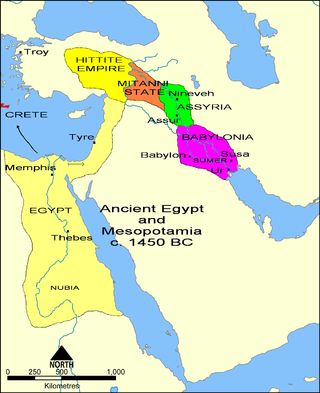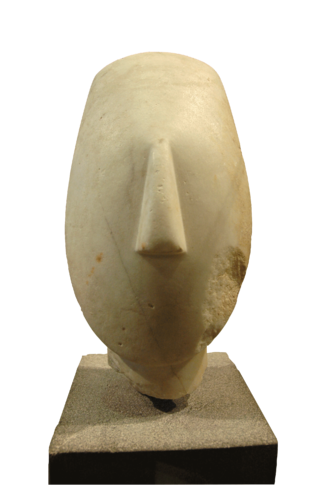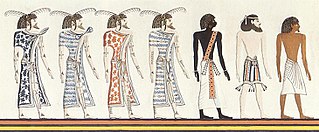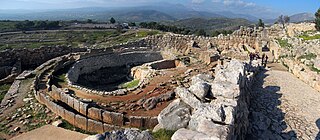| Millennium |
|---|
| 2nd millennium BC |
| Centuries |
| Timelines |
| State leaders |
| Decades |
| Categories: |
| Births – Deaths Establishments – Disestablishments |

The 13th century BC was the period from 1300 to 1201 BC.
| Millennium |
|---|
| 2nd millennium BC |
| Centuries |
| Timelines |
| State leaders |
| Decades |
| Categories: |
| Births – Deaths Establishments – Disestablishments |

The 13th century BC was the period from 1300 to 1201 BC.


Aegean civilization is a general term for the Bronze Age civilizations of Greece around the Aegean Sea. There are three distinct but communicating and interacting geographic regions covered by this term: Crete, the Cyclades and the Greek mainland. Crete is associated with the Minoan civilization from the Early Bronze Age. The Cycladic civilization converges with the mainland during the Early Helladic ("Minyan") period and with Crete in the Middle Minoan period. From c. 1450 BC, the Greek Mycenaean civilization spreads to Crete, probably by military conquest. The earlier Aegean farming populations of Neolithic Greece brought agriculture westward into Europe before 5,000 BC.

The Bronze Age is a historic period, lasting from approximately 3300 BC to 1200 BC. It is characterized by the use of bronze, the use of writing in some areas, and other features of early urban civilization. The Bronze Age is the second principal period of the three-age system proposed in 1836 by Christian Jürgensen Thomsen for classifying and studying ancient societies and history. It is also considered the second phase of three, in the Metal Ages.

Linear B is a syllabic script that was used for writing in Mycenaean Greek, the earliest attested form of the Greek language. The script predates the Greek alphabet by several centuries, the earliest known examples dating to around 1400 BC. It is adapted from the earlier Linear A, an undeciphered script potentially used for writing the Minoan language, as is the later Cypriot syllabary, which also recorded Greek. Linear B, found mainly in the palace archives at Knossos, Kydonia, Pylos, Thebes and Mycenae, disappeared with the fall of Mycenaean civilization during the Late Bronze Age collapse. The succeeding period, known as the Greek Dark Ages, provides no evidence of the use of writing.

Mycenae is an archaeological site near Mykines in Argolis, north-eastern Peloponnese, Greece. It is located about 120 kilometres south-west of Athens; 11 kilometres north of Argos; and 48 kilometres south of Corinth. The site is 19 kilometres inland from the Saronic Gulf and built upon a hill rising 900 feet above sea level.
The 12th century BC is the period from 1200 to 1101 BC. The Late Bronze Age collapse in the ancient Near East and eastern Mediterranean is often considered to begin in this century.
The 14th century BC was the century that lasted from the year 1400 BC until 1301 BC.

The 15th century BC was the century that lasted from 1500 BC to 1401 BC.
The 16th century BC was a century that lasted from 1600 BC to 1501 BC.

The 1300s BC is a decade which lasted from 1309 BC to 1300 BC.

Yinxu is the site of one of the ancient and major historical capitals of China. It is the source of the archeological discovery of oracle bones and oracle bone script, which resulted in the identification of the earliest known Chinese writing. The archeological remnants known as Yinxu represent the ancient city of Yin, the last capital of China's Shang dynasty which existed through eight generations for 255 years, and through the reign of 12 kings. Yinxu was discovered, or rediscovered, in 1899. It is now one of China's oldest and largest archeological sites, and was selected as a UNESCO World Heritage Site in 2006. Yinxu is located in northernmost Henan province near the modern city of Anyang, and near the Hebei and Shanxi province borders. Public access to the site is permitted.

Mycenaean Greece was the last phase of the Bronze Age in ancient Greece, spanning the period from approximately 1750 to 1050 BC. It represents the first advanced and distinctively Greek civilization in mainland Greece with its palatial states, urban organization, works of art, and writing system. The Mycenaeans were mainland Greek peoples who were likely stimulated by their contact with insular Minoan Crete and other Mediterranean cultures to develop a more sophisticated sociopolitical culture of their own. The most prominent site was Mycenae, after which the culture of this era is named. Other centers of power that emerged included Pylos, Tiryns, and Midea in the Peloponnese, Orchomenos, Thebes, and Athens in Central Greece, and Iolcos in Thessaly. Mycenaean settlements also appeared in Epirus, Macedonia, on islands in the Aegean Sea, on the south-west coast of Asia Minor, and on Cyprus, while Mycenaean-influenced settlements appeared in the Levant and Italy.

Merneptah or Merenptah was the fourth pharaoh of the Nineteenth Dynasty of Ancient Egypt. He ruled Egypt for almost ten years, from late July or early August 1213 BC until his death on 2 May 1203 BC, according to contemporary historical records. He was the first royal-born pharaoh since Tutankhamun of the Eighteenth Dynasty.

Aegean art is art that was created in the lands surrounding, and the islands within, the Aegean Sea during the Bronze Age, that is, until the 11th century BC, before Ancient Greek art. Because is it mostly found in the territory of modern Greece, it is sometimes called Greek Bronze Age art, though it includes not just the art of the Mycenaean Greeks, but also that of the non-Greek Cycladic and Minoan cultures, which converged over time.

The Late Bronze Age collapse was a time of widespread societal collapse during the 12th century BCE associated with environmental change, mass migration, and the destruction of cities. The collapse affected a large area of the Eastern Mediterranean and the Near East, in particular Egypt, eastern Libya, the Balkans, the Aegean, Anatolia, and, to a lesser degree, the Caucasus. It was sudden, violent, and culturally disruptive for many Bronze Age civilizations, and it brought a sharp economic decline to regional powers, notably ushering in the Greek Dark Ages.

The Libu were an Ancient Libyan tribe of Berber origin, from which the name Libya derives.

The Achaeans were one of the four major tribes into which Herodotus divided the Greeks, along with the Aeolians, Ionians and Dorians. They inhabited the region of Achaea in the northern Peloponnese, and played an active role in the colonization of Italy, founding the city of Kroton. Unlike the other major tribes, the Achaeans did not have a separate dialect in the Classical period, instead using a form of Doric.

Grave Circle A is a 16th-century BC royal cemetery situated to the south of the Lion Gate, the main entrance of the Bronze Age citadel of Mycenae in southern Greece. This burial complex was initially constructed outside the walls of Mycenae and ultimately enclosed in the acropolis when the fortification was extended during the 13th century BC. Grave Circle A and Grave Circle B, the latter found outside the walls of Mycenae, represents one of the significant characteristics of the early phase of the Mycenaean civilization.

Attarsiya was an Ahhiyan warlord who lived around 1400 BC. He is known from a single Hittite text, which recounts his military activities in Western Anatolia and Alasiya. These texts are significant because they provide the earliest textual evidence of Mycenaean Greek involvement in Western Anatolian affairs. Scholars have noted potential connections between his name and that of Atreus from Greek mythology.
The religious element is difficult to identify in Mycenaean Greece, especially as regards archaeological sites, where it remains very problematic to pick out a place of worship with certainty. John Chadwick points out that at least six centuries lie between the earliest presence of Proto-Greek speakers in Hellas and the earliest inscriptions in the Mycenaean script known as Linear B, during which concepts and practices will have fused with indigenous Pre-Greek beliefs, and—if cultural influences in material culture reflect influences in religious beliefs—with Minoan religion. As for these texts, the few lists of offerings that give names of gods as recipients of goods reveal little about religious practices, and there is no other surviving literature.

The military nature of Mycenaean Greece in the Late Bronze Age is evident by the numerous weapons unearthed, warrior and combat representations in contemporary art, as well as by the preserved Greek Linear B records. The Mycenaeans invested in the development of military infrastructure with military production and logistics being supervised directly from the palatial centres.